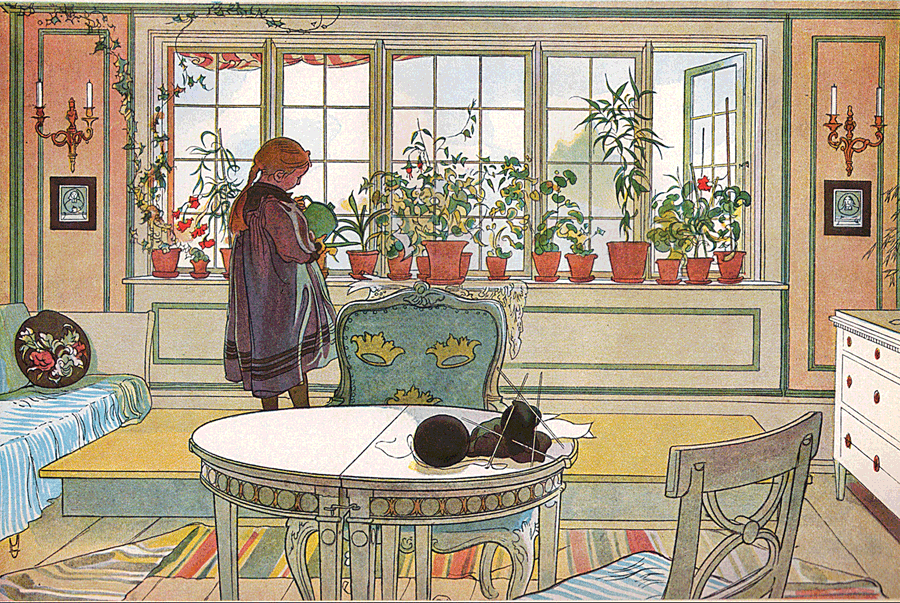
Carl Larsson, a renowned Swedish painter, was born May 28, 1853 in Stockholm, Sweden. His oils, watercolors, and frescoes, are some of the most beautiful and poignant paintings to be seen anywhere. His paintings are shown at the Art Institute of Chicago, the National Gallery of Art, and at museums in Cleveland, Minneapolis, Italy, Denmark, and Finland.
There are a number of his paintings that I find especially captivating. Those include “Flowers on the Windowsill,” “Christmas Eve,” “Breakfast under the big birch,” and “Cosy Corner in a Home.” The paintings are crisp, clean, evocative, and charming. The simplicity of design enchants.
Carl’s childhood was not happy because his parents were extremely poor. The family lived with two other families with one room for each where a biographer recorded: “Penury, filth, and vice thrived. Leisurely seethed and smouldered, eaten-away, and rotten bodies and souls.”
His father was a casual laborer working for a time as a mere grain carrier at a nearby mill. Larsson portrays him as a loveless man lacking self-control. His father drank, ranted, and raved, and told his son that “I curse the day you were born.” Carl’s mother worked long hours as a laundress to help provide for their family.
Larsson was enrolled in the school for poor children and at the age of 13, his teacher urged him to apply to the “principskola” of the Royal Swedish Academy of Arts where he was admitted. His first years there were bordered by the fact that he felt socially inferior, confused, and shy.
In 1869 at age 16, he was promoted to the “antique school” at the academy. He gained confidence and became a central figure in student life. He earned his first medal in nude drawing. He worked as a caricaturist for the humorous paper Kasper and as a graphic artist for the newspaper Ny Illustrerad Tidning. His annual wages were sufficient to allow him to help support his parents financially.
Larsson moved to Paris in 1877 after years of working as an illustrator of books, magazines, and newspapers. He lived there several frustrating years as a hard-working artist without any success. He chose to settle down with other Swedish painters in Grez-dur-Loing which was a Scandinavian artists’ colony outside Paris. There he met the artist Karin Bergoo, who soon became his wife, and mother of their eight children.
In 1888 the family was given a small house in Sundbor by Karin’s father. They named the home Little Hyttnas. Carl suffered from bouts of depression. In later years he had eye problems and the worsening of his frequent headaches.
The Swedish publisher Bonnier published books written and illustrated by Larsson and his popularity increased. So much so that “The House in the Sun” immediately became one of the German publishing industry’s best sellers of the year with more than 40,000 copies in three months. More than 40 print runs were produced up to 2001. Both Carl and Karin Larsson thought themselves overwhelmed by such success.
Larsson considered his work in schools, museums, and other public buildings to be his most important frescos. His last monumental work, Midvinterblot (Midwinter Sacrifice) oil painting was completed in 1915. It had been commissioned for a wall in the Swedish National Museum in Stockholm. However, the board of the museum rejected it. Decades later, the painting was purchased and placed in the Swedish National Museum of Fine Arts.
This great Swedish artist, Carl Larsson, died January 22, 1919 at age 65 in Falun, Sweden. His masterpiece works live on in perpetuity.

Wikipedia photo

